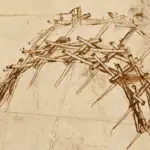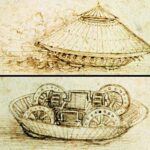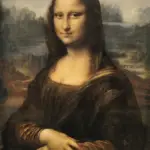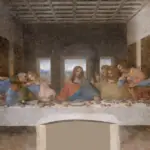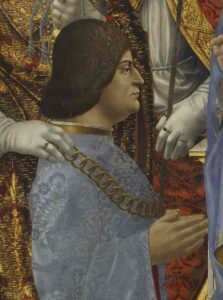
Ludovico Sforza (1452-1508)
Ludovico Sforza, known as “Il Moro,” was a significant figure in Renaissance Italy. He was renowned for his patronage of the arts and tumultuous reign as the Duke of Milan from 1494 to 1499. This article will offer you insights into his achievements and challenges.
By the end of this read, you will understand Sforza’s pivotal role and influence on famous artists like Leonardo da Vinci.
As a member of the Sforza dynasty, Ludovico was instrumental in transforming Milan into a vibrant center of cultural and technological advancement. He sponsored numerous projects, such as engineering endeavors and artistic commissions, that left a lasting legacy on the city’s heritage.
Ludovico Sforza is perhaps best remembered for his support of Leonardo da Vinci, whose iconic works, such as “The Last Supper,” were created during Sforza’s rule.
Despite his contributions, Ludovico’s reign was marked by political strife and alliances, eventually leading to his downfall. Competing interests from France and the Holy Roman Empire created a turbulent environment, challenging his leadership and ultimately leading to his capture.
For more on the complex history of the House of Sforza, his legacy provides a compelling study of power, art, and ambition in Renaissance Europe.
Early Life and Rise to Power
Ludovico Sforza was a key figure in late 15th-century Italian politics and a renowned arts patron. Throughout his life, he navigated complex family dynamics and Italian politics to secure power as the Duke of Milan.
Birth and Family Background
Ludovico Maria Sforza was born on July 27, 1452, in Vigevano, part of the Duchy of Milan. He was the son of Francesco Sforza, a leading military commander-turned-Duke, and Bianca Maria Visconti.
As part of the influential Sforza family, Ludovico was involved in the political intricacies of the time from a young age. Being the fourth son, he was initially not seen as an heir to the duchy.
Despite this, his ambition and intelligence positioned him for eventual leadership. His family ties and early connections with important figures throughout Italy were vital in his future ascent to power.
Education and Early Influences
Ludovico’s education focused on the humanistic ideals of the Renaissance, emphasizing arts and politics. Growing up surrounded by Renaissance art and culture, he developed a passion for artistic patronage.
His early influencers included scholars and artists such as Leonardo da Vinci, whose work in Milan shaped both Ludovico’s artistic tastes and political strategies.
He cultivated relationships with thinkers and artists, which later benefited his rule. These connections supported Ludovico’s political maneuvers and helped solidify his power base.
Path to Duchy of Milan
Despite being Francesco Sforza’s fourth son, Ludovico skillfully navigated the political landscape to claim the title of Duke of Milan. After his elder brother Galeazzo Maria Sforza’s assassination, Ludovico became involved in the regency, strategically outmaneuvering his nephews in the power struggle.
By 1494, he positioned himself as the duchy’s powerhouse. He officially assumed the role of Duke amid complex alliances and rivalries, including those with the French and Habsburg (Maximilian I of Austria). He secured his rule by exploiting external pressures from European powers.
This strategic ascent marked a significant period in Milanese history, with Ludovico leaving a lasting impact through his rule and patronizing the arts.
Ducal Reign and Administration
Ludovico Sforza played a complex role during his tenure as Duke of Milan. His reign included solidifying power, enforcing new policies, and interacting strategically with other Italian states.
Consolidation of Power
Ludovico Sforza, the Duke of Milan, rose to power during a turbulent time in Italian history. As the fourth son, he wasn’t originally expected to rule. He significantly increased his influence through strategic marriages and alliances, such as his bond with Caterina Sforza.
He secured support from important figures, employing clever political maneuvers to establish his dominion. His leadership was solidified when he was declared regent for his young nephew, further tightening his control over Milan. This period marked a significant power shift, enabling Ludovico to implement his ambitious plans.
Policies and Governance
Cultural and economic advancements characterized Ludovico’s governance. He supported Leonardo da Vinci as an arts patron, commissioning works like “The Last Supper” and contributing to Milan’s cultural richness.
He also invested in agricultural innovations and irrigation projects, enhancing the region’s economic well-being. His vision and support for the arts and science ushered in a prosperous era, indicative of his influence across various facets of life in Milan. This approach was crucial in maintaining the city’s status as a Renaissance hub.
Relationship with the Italian States
Ludovico maintained a delicate balance in his relations with other Italian states. He sought to expand his influence beyond Milan through strategic alliances and warfare. His interactions with France were pivotal, as they offered opportunities and challenges.
Despite his diplomatic efforts, conflict with France eventually led to Milan’s occupation, and Ludovico’s eventual capture and imprisonment highlighted the volatile nature of Italian politics. His reign exemplified the intricate web of allegiances and rivalries that defined the Italian states during this period.
Patronage of the Arts
Duke of Milan, Ludovico Sforza, significantly influenced the Renaissance through his art patronage. His support for artists like Leonardo da Vinci and investment in cultural projects like the Sforza Castle contributed to Milan’s status as a key cultural hub during this period.
Support for Leonardo da Vinci
Ludovico Sforza was instrumental in supporting Leonardo da Vinci’s works. As a patron, he enabled da Vinci to pursue various artistic and scientific endeavors, which were crucial in creating masterpieces such as The Last Supper.
A mutual appreciation for innovation marked the partnership between Sforza and da Vinci. Sforza provided da Vinci with resources and opportunities to apply his talents in art and engineering projects.
This relationship exemplifies how influential patrons like Sforza could foster the careers of great artists during the Renaissance.
Sforza Castle and Cultural Projects
Under Ludovico’s rule, the Sforza Castle in Milan became a center of cultural enhancement. He funded extensive renovations, making the castle a symbol of Milanese power and culture. These projects included hiring renowned artists and architects to redesign and expand the structure.
The castle didn’t just serve as a fortress but also as a vibrant hub for artistic expression. It hosted various activities, from musical performances to art exhibitions, reflecting Sforza’s ambition to position Milan as a cultural leader. This investment in cultural projects also had lasting effects, as elements of the castle can still be admired today.
Impact on Renaissance Art
The impact of Ludovico Sforza’s patronage on Renaissance art was profound. By supporting artists like Leonardo da Vinci and commissioning grand architectural projects, he helped Milan emerge as a Renaissance powerhouse. This patronage allowed for the creation of iconic artwork and significant advancements in artistic techniques.
His influence extended beyond individual artists to the broader art community, encouraging a culture that valued creativity and excellence. This focus on the arts contributed to the spread of European Renaissance ideals and reinforced Milan’s reputation as a cradle of creativity and innovation.
Ludovico Sforza and Leonardo da Vinci
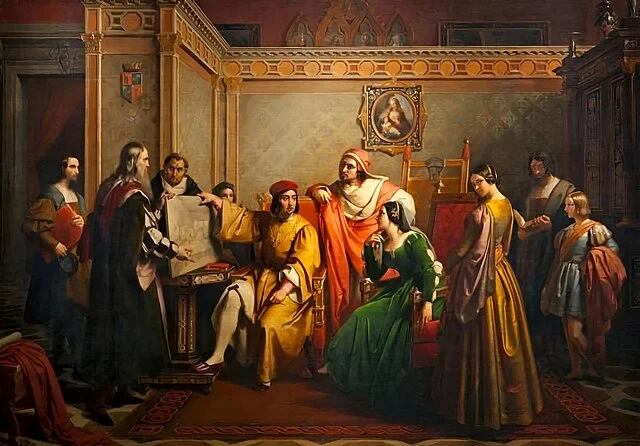
Leonardo da Vinci presents his Last Supper sketch to Duke Ludovico il Moro. At the center are the Duke, Duchess Beatrice, and Cardinal Ascanio, as depicted by Francesco Podesti in 1846.
Sforza’s Recruitment For Leonardo da Vinci
One of Ludovico Sforza’s most enduring legacies was his patronage of the polymath genius Leonardo da Vinci. Recognizing Leonardo’s unmatched talent, Ludovico invited him to Milan in 1482. This planned move was not merely about collecting art; it was a strategic endeavor to augment the cultural prestige of his court and city.
Roles Leonardo Played under Sforza’s Patronage
Under Sforza’s patronage, Leonardo da Vinci flourished as a painter, sculptor, architect, engineer, and scientist. In addition to producing iconic art, Leonardo was involved in several projects, from developing military strategies to designing canal systems. His diverse roles under Ludovico’s rule showcased his talents far beyond the realm of painting.
His Significant Projects and Inventions
Leonardo’s tenure in Milan under Ludovico’s patronage led to the conception of several groundbreaking projects and inventions. His works spanned numerous disciplines, including civil engineering, aeronautics, and military science. His sketches of ‘flying machines’ inspired future generations of aviation, while his designs for war machines revolutionized military engineering.
Key Artworks Commissioned by Sforza
While serving Ludovico, Leonardo da Vinci created some of his most celebrated works. These include the iconic ‘The Last Supper,’ a mural that continues to captivate audiences with its emotional depth and compositional innovation. Leonardo also began the monumental project of a horse statue, known as the ‘Gran Cavallo,’ which, although never completed, symbolized the ambition and grandeur of the Sforza court.
Another notable work is the ‘Madonna Litta,’ a testament to Leonardo’s mastery of portraying human emotion. The Codex Atlanticus, a collection of Leonardo’s drawings and writings compiled during his time in Milan, is an extraordinary record of Renaissance ideas.
Military Campaigns and Conflicts
Ludovico Sforza, known as Ludovico il Moro, was deeply involved in the military and political turmoil of the Italian Wars. His strategic alliances and conflicts significantly impacted the Duchy of Milan.
Italian Wars Involvement
The Italian Wars, beginning in the late 15th century, saw Ludovico Sforza’s significant involvement as a key figure. He allied with Charles VIII of France to secure his position in Milan.
This alliance, though strategic, led to a series of conflicts across Italy. Ludovico’s shifting allegiances were instrumental in forming the League of Venice, which aimed to push French forces out of Italy.
His involvement in these wars was marked by military maneuvers and diplomatic negotiations to maintain Milan’s independence and power.
Alliances and Rivalries
Ludovico Sforza engaged in complex alliances and rivalries as the Duke of Milan. His initial support for French forces turned against him, leading to partnerships with other Italian states and Spain.
The fluctuating allegiances created numerous adversaries and friends. Notably, his rivalry with the Republic of Venice was significant.
He was also known for his diplomatic relations with Maximilian in the Holy Roman Empire. These alliances and rivalries were strategic moves to retain authority in Milan amidst European power struggles.
Defense of Milan
The defense of Milan was a priority for Ludovico Sforza, particularly during France’s attempts to assert control.
As Duke, Ludovico fortified Milan against external threats. His military tactics and investments in fortifications, such as the castle in Milan, were crucial in defending the city.
Milan eventually fell to French forces in the Battle of Novara despite his efforts, leading to his capture. His time as Duke was characterized by a relentless defense of Milan, highlighting his commitment to retaining its regional autonomy and influence.
Downfall and Imprisonment
Ludovico Sforza encountered significant challenges in maintaining power during the late 15th century. His eventual capture and imprisonment marked the end of his rule and had lasting effects on his legacy.
Capture by the French
In 1499, Ludovico Sforza, often called Ludovico il Moro, faced an invasion by French forces led by King Louis XII. Seeking to reclaim Milan, Louis had a strong claim through his grandmother, Valentina Visconti.
Ludovico attempted to recruit Swiss mercenaries to defend his position. Despite these efforts, the French army proved too strong.
By April 1500, Ludovico was captured after being betrayed by his Swiss troops. This marked a significant turning point in Milan’s history, ending Ludovico’s rule and altering the region’s political landscape.
Life in Captivity
Once captured, Ludovico Sforza was imprisoned in the Château de Loches in France. His life in captivity was one of isolation and despair. He spent almost eight years there until he died in 1508.
During this time, he was largely cut off from the outside world, which weighed heavily on him.
Despite his situation, Ludovico remained a figure of intrigue. He was recognized for his earlier role as a patron of the arts, notably supporting Leonardo da Vinci.
The isolation didn’t overshadow his contributions to the Italian Renaissance, though his direct influence waned during these years.
Legacy after Death
Ludovico Sforza’s legacy endured well beyond his death in 1508. Often remembered for his patronage of Leonardo da Vinci, his rule was marked by cultural achievements, including da Vinci’s renowned “The Last Supper.”
Ludovico’s impact on Milan’s artistic and political environment remained significant despite his downfall. His descendants, including Francesco II Sforza, carried on the Sforza name, though they did not achieve the same power level.
Today, his contributions to art and culture are still celebrated, while the Sforza family remains a topic of historical interest.
Personal Life and Relationships

Ludovico Sforza receives the Imperial fief of Milan from Maximilian, with Bianca Maria as his consort.
Ludovico Sforza had complex personal ties that shaped his reign. His marriages, communications with notable figures, and the impact on his descendants showcase his influence during the Italian Renaissance.
Marriages and Issue
Ludovico Sforza married Beatrice d’Este in a politically motivated union. Their marriage was significant, aligning two powerful families.
They had two sons, Maximilian and Francesco II Sforza. Their offspring played key roles in Milan’s politics, especially during tumultuous succession disputes.
Additionally, Ludovico maintained a liaison with Lucrezia Crivelli, resulting in another son, Giovanni Paolo I Sforza.
These connections, both formal and informal, solidified Ludovico’s standing among the Italian nobility and impacted Milan’s history.
Correspondence and Personal Traits
Ludovico Sforza engaged in numerous correspondences, notably with Leonardo da Vinci. His letter to Ludovico requesting employment illustrates the duke’s influence as a patron.
Renowned for his diplomatic acumen, Ludovico was pragmatic and resilient. Despite political challenges, including French threats to his rule, he exhibited impressive strategic skills.
These traits, combined with his intellectual pursuits, underscored his ability to navigate and manipulate the political landscape of Renaissance Italy.
Influence on Descendants
Ludovico Sforza’s lineage, known as “the Moor” due to his dark complexion, continued to exert influence long after his death. His sons, especially Francesco II, contributed to political transitions within Milan.
Despite eventual decline, the Sforza family remains notable for their Renaissance contributions.
Ludovico’s descendants endured through strategic marriages and alliances, albeit with diminishing power. This legacy is marked by their enduring cultural and political residues in Italian history.
Cultural Depictions and Historiography
Ludovico Sforza, known as “Il Moro,” has influenced historical and cultural narratives. His role as a patron of the arts and his tumultuous reign in Milan offer rich material for artistic and scholarly exploration.
Representations in Literature and Art
Ludovico Sforza is a profound presence in literature and art. His close relationship with Leonardo da Vinci highlights his significant role as a patron.
One notable example is Leonardo da Vinci’s “The Last Supper,” commissioned under his patronage and remains a pinnacle of Renaissance art.
Literature often portrays him as a complex figure who mixes ambition with vulnerability. His character appears in historical novels, and his political maneuvers and court life are dramatized in series like The Borgias.
The nickname “Il Moro,” meaning “The Moor,” adds intrigue and identity to his portrayals.
Modern Historical Reassessment
Recent historical studies have reevaluated Ludovico Sforza’s impact on Milan and the Renaissance. Known also as Ludovico Il Moro, scholars debate his leadership effectiveness and cultural contributions.
Modern historians highlight his patronage of artists, notably da Vinci, and his role in transforming Milan into a cultural hub.
Recent discoveries support the meticulous planning reflected in his strategies for fortification and involvement in secret passages and tunnels.
While his political endeavors ended in imprisonment and death, his legacy in the arts and architecture continues to be reassessed, emphasizing his contributions to the Milanese Renaissance and beyond.
Final Thoughts
Ludovico Sforza was a significant patron of the arts during the Italian Renaissance. His support attracted notable artists, including Leonardo da Vinci.
As the Duke of Milan, Ludovico commissioned ambitious projects like the renowned Last Supper mural. This commission reflects his commitment to cultural patronage.
Despite setbacks, such as political struggles and the eventual fall of Milan to French forces, he left a lasting mark on Milan’s artistic landscape.
His leadership fostered a culturally rich environment during a pivotal time in history.
Frequently Asked Questions
Ludovico Sforza played a significant role as the Duke of Milan during the Renaissance, influencing politics and the arts. His connections with figures like Leonardo da Vinci and the cultural developments during his time mark key aspects of his legacy.
Why was Ludovico Sforza important?
Ludovico Sforza was a pivotal Duke of Milan figure known for fostering Renaissance art and culture. He patronized artists like Leonardo da Vinci, which helped make Milan a center of Renaissance culture. His political maneuvers and ambitions also impacted the Italian peninsula.
Who is Duke Ludovico Sforza?
Ludovico Sforza, also known as Ludovico il Moro, was the Duke of Milan. He ruled from 1494 to 1499 and was notable for his patronage of the arts and efforts to strengthen Milan’s political power. He was incredibly influential in the development of early modern military tactics.
Does the Sforza family still exist?
Once mighty in Milan, the Sforza family diminished in political influence over the centuries. While the family does not hold the power it once did, descendants of the Sforza family still exist today, but they are less prominent in contemporary public affairs.
How did Leonardo da Vinci impress Ludovico Sforza?
Leonardo da Vinci impressed Ludovico Sforza with his diverse art, science, and engineering talents. His detailed art and innovative designs captivated Ludovico, who became his patron. Notably, da Vinci painted the iconic “The Last Supper” during his time with Ludovico.
Who was Leonardo da Vinci’s patron for the Last Supper?
Leonardo da Vinci’s patron for “The Last Supper” was Ludovico Sforza. This commission was completed while da Vinci worked in Milan and under Ludovico’s patronage. The painting is regarded as one of Leonardo’s masterpieces.
Who killed Sforza in Medici?
The series Medici fictionalizes Ludovico Sforza and dramatizes events for historical narrative. However, the show does not provide a historically accurate account of who killed Sforza. Historically, Ludovico Sforza was imprisoned by the French and died in captivity.
How long did Da Vinci stay in the court of Ludovico Sforza?
Leonardo da Vinci stayed in the court of Ludovico Sforza from 1482 to 1499, a period of about 17 years, during which time he produced some of his most famous works, including “The Last Supper.” His extended stay in Milan marks a significant period in his career.
Who is Sforza in Medici?
In “Medici,” Ludovico Sforza is portrayed as a strategic and ambitious Duke of Milan. His character reflects his historical role in Italian politics and his artistic patronage. The show’s portrayal is dramatized but provides insight into his influence during the Renaissance.
Who was Leonardo da Vinci’s patron in Florence?
Leonardo da Vinci’s patron in Florence was Lorenzo de’ Medici. Lorenzo was a member of the powerful Medici family, known for supporting artists and intellectuals. Lorenzo recommended Leonardo to work in Milan under Ludovico Sforza’s patronage.
Why did Ludovico Sforza commission the Last Supper?
Ludovico Sforza commissioned “The Last Supper” to enhance Milan’s artistic and cultural standing. The painting was intended for the refectory of the Convent of Santa Maria delle Grazie and reflected Ludovico’s desire to leave a lasting cultural legacy.
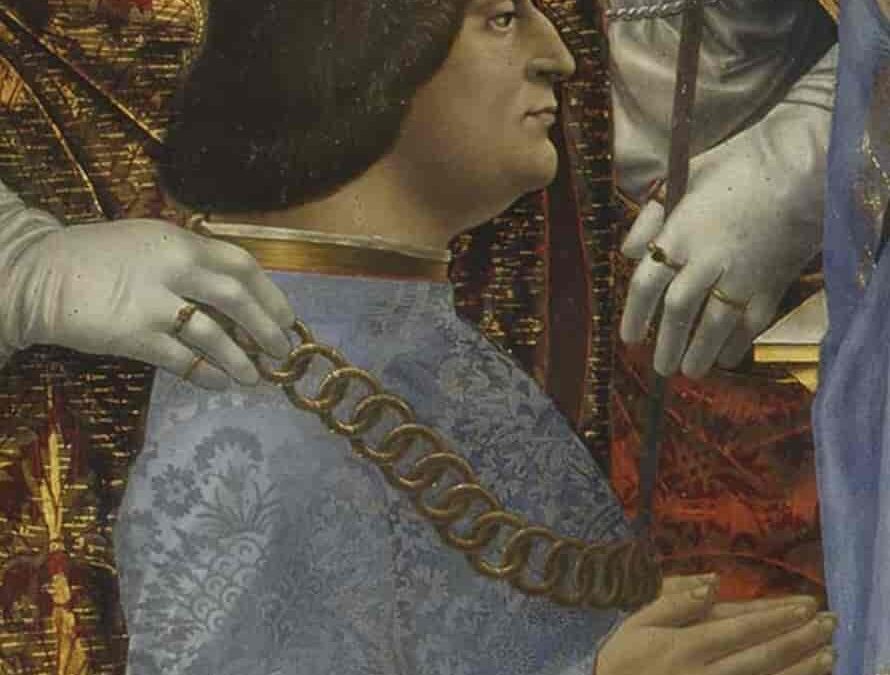
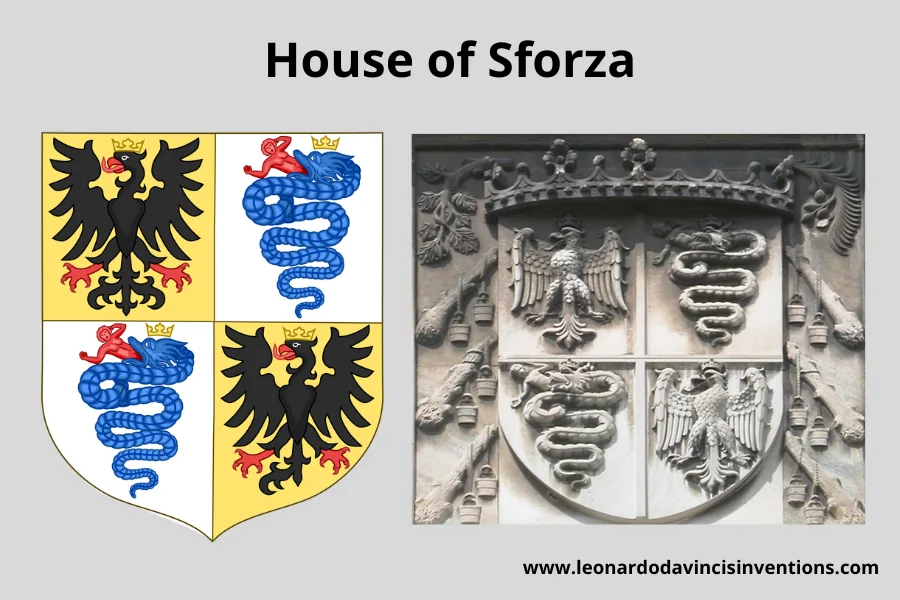
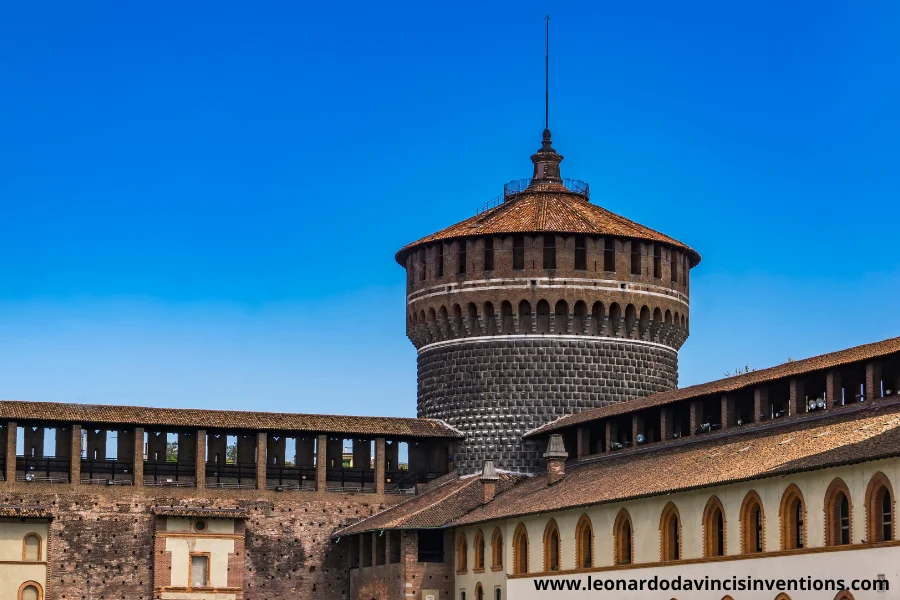
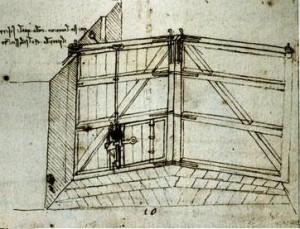
 I’m Leonardo Bianchi, the mind behind Leonardo da Vinci's Inventions. Thanks for visiting.
I’m Leonardo Bianchi, the mind behind Leonardo da Vinci's Inventions. Thanks for visiting. 